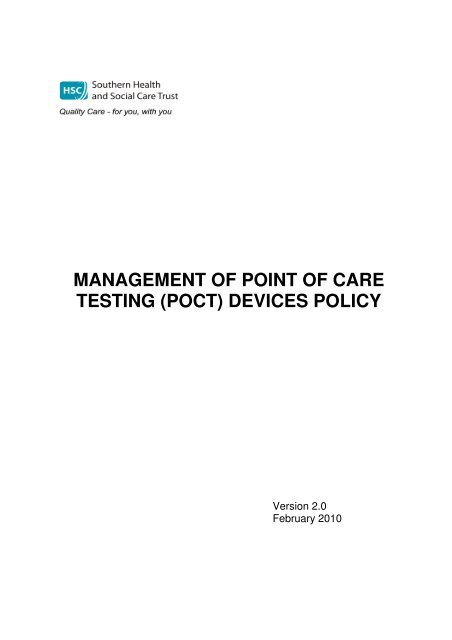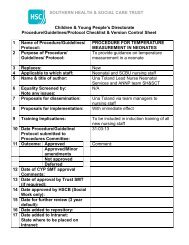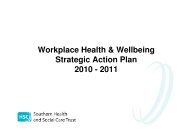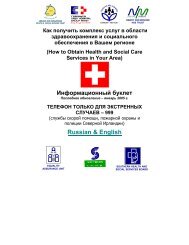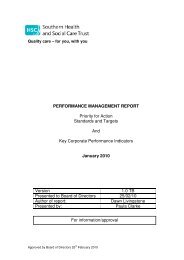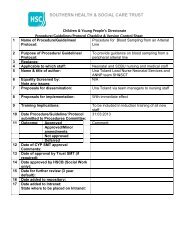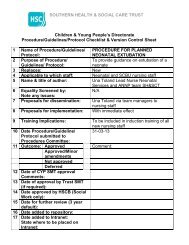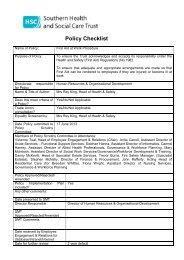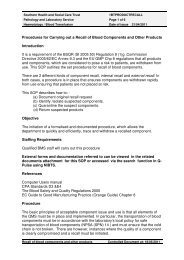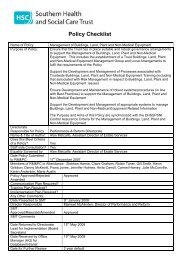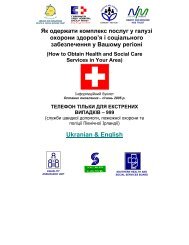Point of Care Testing Policy - Southern Health and Social Care Trust
Point of Care Testing Policy - Southern Health and Social Care Trust
Point of Care Testing Policy - Southern Health and Social Care Trust
Create successful ePaper yourself
Turn your PDF publications into a flip-book with our unique Google optimized e-Paper software.
MANAGEMENT OF POINT OF CARETESTING (POCT) DEVICES POLICYVersion 2.0February 2010
Name <strong>of</strong> <strong>Policy</strong>:Purpose <strong>of</strong> <strong>Policy</strong>:Directorate responsible for<strong>Policy</strong>Name & Title <strong>of</strong> Author:Does this meet criteria <strong>of</strong> a<strong>Policy</strong>?Staff side consultation?Equality Screened by:<strong>Policy</strong> ChecklistManagement <strong>of</strong> <strong>Point</strong> <strong>of</strong> <strong>Care</strong> <strong>Testing</strong> DevicesTo manage POCT effectively <strong>and</strong> limit risk associated with its use.Acute Services DirectorateDr Peter Sharpe Consultant Chemical Pathologist, Chairperson POCTCommitteeDr Derek McKillop, Principal Clinical Scientist, POCT Co-ordinator.YesYesPOCT committee membersDate <strong>Policy</strong> submitted to <strong>Policy</strong> 1 st March 2010Scrutiny CommitteeMembers <strong>of</strong> <strong>Policy</strong> Scrutiny Committee in attendance: Kieran Donaghy, Stephen McNally, Siobhan Hanna,John Graham, Dawn Connolly, Danny McKevitt, Vivienne Toal.<strong>Policy</strong> Approved/Rejected/AmendedCommunication Plan required?Implementation Plan requested; Sent <strong>and</strong> full policy approved byScrutiny Committee on 14/6/10The POCT <strong>Policy</strong> will be communicated to all <strong>Trust</strong> Staff through(a) The Staff Newsletters – Up2date <strong>and</strong> Staff Ebriefing(b) POCT device specific training(c) POCT web site(d) POCT application processTraining Plan required?Implementation Plan required?Any other comments:As stated on the POCT training SOP, All Staff involved in POCTwill be provided device training that will include an overview <strong>of</strong> the<strong>Trust</strong> POCT policy <strong>and</strong> how to locate the policy <strong>and</strong> other relevantdocumentation.Training provision will be advertised by Global email, POCT website <strong>and</strong> through Staff Newsletters – Up2date <strong>and</strong> Ebriefing.Coordinated by the POCT committeeDate presented to SMT 23/06/10Director ResponsibleDr Gillian RankinSMT Approved/Rejected/Amended ApprovedSMT Comments Additional comment added to 6.1.1Date returned to Directorate Lead forimplementation (Board Secretary)Date received by Office Manager (HQ)for database/IntranetDate for further review2 year default<strong>Southern</strong> <strong>Health</strong> <strong>and</strong> <strong>Social</strong> <strong>Care</strong> <strong>Trust</strong>Management <strong>of</strong> <strong>Point</strong> <strong>of</strong> <strong>Care</strong> <strong>Testing</strong> Devices <strong>Policy</strong> V 2.0 February 2010Page 2 <strong>of</strong> 11
POLICY DOCUMENT – VERSION CONTROL SHEETTitleSupersedesOriginator<strong>Policy</strong> Scutiny Committee &SMT approvalCirculationReviewManagement <strong>of</strong> <strong>Point</strong> <strong>of</strong> <strong>Care</strong> <strong>Testing</strong> devicesVersion: 2_0Reference number/document name:Supersedes:Description <strong>of</strong> Amendments(s)/Previous <strong>Policy</strong> or Version:Legacy <strong>Trust</strong> policies related to the management <strong>of</strong> <strong>Point</strong> <strong>of</strong> <strong>Care</strong> <strong>Testing</strong>devicesDr Peter Sharpe Consultant Chemical Pathologist, Chairperson POCTCommitteeDr Derek McKillop, Principal Clinical Scientist, POCT Co-ordinator.Referred for approval by:Date <strong>of</strong> Referral:<strong>Policy</strong> Scrutiny Committee Approval (Date)SMT approval (Date)Issue Date:Circulated By:Issued To: As per circulation List (details below)Review Date:Responsibility <strong>of</strong> (Name): Dr Peter SharpeTitle: Consultant Chemical Pathologist, Chairperson POCT CommitteeCirculation List:<strong>Southern</strong> <strong>Health</strong> <strong>and</strong> <strong>Social</strong> <strong>Care</strong> <strong>Trust</strong>Management <strong>of</strong> <strong>Point</strong> <strong>of</strong> <strong>Care</strong> <strong>Testing</strong> Devices <strong>Policy</strong> V 2.0 February 2010Page 3 <strong>of</strong> 11
ContentsPage Number1.0 Introduction………………………………………………………. 52.0 Definitions………………………………………………………… 53.0 Purpose <strong>and</strong> Aims………………………………………………. 54.0 <strong>Policy</strong> Statement………………………………………………… 55.0 Scope <strong>of</strong> the <strong>Policy</strong>……………………………………………… 76.0 Responsibilities…………………………………………………. 77.0 Legislative Compliance, Relevant Policies Procedures &Guidance…………………………………………………………98.0 Equality <strong>and</strong> Human Rights Considerations………………... 99.0 Sources <strong>of</strong> Advice <strong>and</strong> Further Information ………………… 10<strong>Southern</strong> <strong>Health</strong> <strong>and</strong> <strong>Social</strong> <strong>Care</strong> <strong>Trust</strong>Management <strong>of</strong> <strong>Point</strong> <strong>of</strong> <strong>Care</strong> <strong>Testing</strong> Devices <strong>Policy</strong> V 2.0 February 2010Page 4 <strong>of</strong> 11
1.0 Introduction.1.1 The appropriate use <strong>of</strong> POCT as an alternative to central laboratorytesting should be considered as a clinical governance 1,2 issue <strong>and</strong>therefore be subject to examination <strong>of</strong> clinical effectiveness. Wherepossible, analytical investigations should be performed in clinicallaboratories or other suitable environments by suitably trained <strong>and</strong>registered laboratory staff 3 . Before deciding whether to implement POCTit is essential for potential users to establish a clinical need, including anexamination as to whether reconfiguration <strong>of</strong> a central laboratory servicewould be a viable option. The clinical need should be evidence basedclearly identifying the risks <strong>and</strong> benefits <strong>of</strong> introducing a POCT service.1.2 This document specifically applies to the use <strong>of</strong> POCT in secondary care<strong>and</strong> community services. General practitioners, pharmacists <strong>and</strong> otherprimary sector users are recommended to adopt the practices outlined inthis policy <strong>and</strong> referenced guidelines, including close liaison with therelevant Pathology Department. This approach facilitates the production<strong>of</strong> ‘quality’ results <strong>and</strong> appropriate management <strong>of</strong> the many associatedrisks.2.0 Definitions2.1 <strong>Point</strong> <strong>of</strong> <strong>Care</strong> <strong>Testing</strong> 4 (POCT) refers to analytical tests undertaken bynon-laboratory staff outside a recognised diagnostic laboratory. Theserange from disposable h<strong>and</strong>-held strip readers to desktop analysers.3.0 Purpose <strong>and</strong> Aims3.1 To manage POCT effectively <strong>and</strong> limit the risks associated with its use.4.0 <strong>Policy</strong> Statement4.1 The <strong>Trust</strong> promotes an open <strong>and</strong> positive approach to <strong>Point</strong> <strong>of</strong> <strong>Care</strong><strong>Testing</strong> devices <strong>and</strong> management.4.2 An effective quality management system must be set up to ensure thatPOCT is carried out according to applicable National <strong>and</strong> Internationalguidelines 4-11 , Clinical Pathology Accreditation (UK) Ltd (CPA)st<strong>and</strong>ards 12-13 <strong>and</strong> <strong>Health</strong> & Safety policies 14-16 .4.3 The <strong>Trust</strong> management <strong>of</strong> POCT should be assessed as part <strong>of</strong> thePathology accreditation process as carried out by Clinical PathologyAccreditation (UK) Ltd (CPA).4.4 A multidisciplinary POCT Committee must be formed within the <strong>Southern</strong><strong>Health</strong> <strong>and</strong> <strong>Social</strong> <strong>Care</strong> <strong>Trust</strong> with representatives from the laboratorydisciplines holding key positions. This committee should have theauthority to regulate <strong>and</strong> oversee the POCT quality management system.<strong>Southern</strong> <strong>Health</strong> <strong>and</strong> <strong>Social</strong> <strong>Care</strong> <strong>Trust</strong>Management <strong>of</strong> <strong>Point</strong> <strong>of</strong> <strong>Care</strong> <strong>Testing</strong> Devices <strong>Policy</strong> V 2.0 February 2010Page 5 <strong>of</strong> 11
The <strong>Trust</strong> Committee should consist <strong>of</strong> representatives from the mainPOCT users <strong>and</strong> stakeholders, <strong>and</strong> should meet no fewer than 3 times ayear. This committee should be positioned within the <strong>Trust</strong>’smanagement structure <strong>and</strong> report as such. A representative <strong>of</strong> the <strong>Trust</strong>’scommittee should attend <strong>and</strong> report to any Regional POCT <strong>and</strong> NorthernIrel<strong>and</strong> Pathology Network POCT meetings.4.5 The core <strong>of</strong> any <strong>Trust</strong>’s quality management system should be basedupon key personnel (with suitable protected time allocation) tasked withimplementing <strong>and</strong> monitoring same (see responsibilities).4.6 The <strong>Trust</strong> should appoint a senior laboratory pr<strong>of</strong>essional to provideClinical <strong>and</strong> Pr<strong>of</strong>essional leadership <strong>of</strong> the POCT service. This individualmust hold FRCPath or equivalent.4.7 All requests for future POCT equipment must be submitted to the POCTcommittee for approval with details <strong>of</strong> clinical need <strong>and</strong> assessment <strong>of</strong>outcomes including costs. The POCT committee should decide on theappropriateness <strong>of</strong> any request, the reliability <strong>and</strong> robustness <strong>of</strong> theequipment available, the interfacing requirements, the risk-benefit <strong>and</strong>cost-benefit analyses, quality assessment <strong>and</strong> compliance with <strong>Trust</strong>policies including infection control 15,16 <strong>and</strong> COSHH 17 . Where necessaryadvice should be sought from the <strong>Trust</strong>’s Infection Control Team <strong>and</strong>POCT departmental leads. The <strong>Trust</strong>’s Supplies Department should notallow purchase <strong>of</strong> POCT devices without prior approval by the POCTcommittee. POCT devices must be procured according to the <strong>Trust</strong>’sSt<strong>and</strong>ing Financial Instructions.4.8 POCT must not be considered where a laboratory can provide a result ina timely manner appropriate to clinical need4.9 All POCT devices adopted should:• Be evaluated <strong>and</strong> procured in collaboration with <strong>Trust</strong> POCTcommittee <strong>and</strong> the POCT departmental leads <strong>of</strong> the appropriatelaboratory department to ensure satisfactory st<strong>and</strong>ards <strong>of</strong>performance <strong>and</strong> safety <strong>and</strong> also conform to the requirements <strong>of</strong>the In Vitro Diagnostics Directive 18 .• Align with laboratory-based methods, where possible <strong>and</strong> practical,in current practice in the <strong>Trust</strong>.• Where possible IT Connectivity should be made available <strong>and</strong>resourced to appropriate specification to allow central management<strong>of</strong> POCT devices <strong>and</strong> documentation <strong>of</strong> results in accordance withrobust quality management• Be used in accordance with manufacturer’s or suppliersinstructions.• Be subject to regular maintenance as specified by the supplyingmanufacturer or supplier.• Details <strong>of</strong> maintenance performed, faults <strong>and</strong> corrective actiontaken, should be documented as per CPA.• Only be used for the purpose it has been evaluated for.<strong>Southern</strong> <strong>Health</strong> <strong>and</strong> <strong>Social</strong> <strong>Care</strong> <strong>Trust</strong>Management <strong>of</strong> <strong>Point</strong> <strong>of</strong> <strong>Care</strong> <strong>Testing</strong> Devices <strong>Policy</strong> V 2.0 February 2010Page 6 <strong>of</strong> 11
4.10 Device specific St<strong>and</strong>ard Operating Procedures must be developed,implemented <strong>and</strong> made available to all POCT users.4.11 Regular Audit <strong>of</strong> POCT must form an integral part <strong>of</strong> any qualitymanagement system.4.12 Appropriate External Quality Assurance <strong>and</strong> Internal Quality Controlprogrammes must be established for all POCT.4.13 Where possible <strong>and</strong> practical, electronic devices rather than devicesrequiring a subjective visual read by the user should be used. (It isrecommended that where such visual read devices are in use, the resultsare checked by at least two trained members <strong>of</strong> staff)4.14 Only trained, certified <strong>and</strong> competent staff should use POCT equipment.Where possible such equipment should be password-protected <strong>and</strong> onlyaccessible to trained / certified users.4.15 All patient <strong>and</strong> quality control testing results must be recorded. Patientresults must be recorded in such detail as to allow unequivocalidentification <strong>of</strong> the patient, the actual result, date <strong>and</strong> time <strong>of</strong> analysis,reagent lot/expiry date <strong>and</strong> the name <strong>of</strong> the analyst. This record must bein addition to records made in the patient notes, <strong>and</strong> where availableshould be electronic. Such records should be kept according toguidelines issued by the RCPath 194.16 All adverse events relating to POCT must be reported back to the POCTcommittee which must have the authority to withdraw or suspend servicein the event <strong>of</strong> a safety-related or performance issue or lack <strong>of</strong> clinical orcost effectiveness.4.17 All staff who recommend the use <strong>of</strong> POCT systems or devices for use bypatients must ensure that the devices have been approved by the <strong>Trust</strong>’sor NI Regional POCT committee.4.18 Management arrangements between the <strong>Trust</strong> Pathology Laboratory <strong>and</strong>POCT users, outside <strong>of</strong> those stated in this document must be agreed<strong>and</strong> documented in a service level agreement5.0 Scope <strong>of</strong> the <strong>Policy</strong>5.1 The policy is applicable to all <strong>of</strong> <strong>Southern</strong> HSC <strong>Trust</strong> sites <strong>and</strong> staffperforming POCT.6.0 Responsibilities6.1 All Staff involved in the provision <strong>of</strong> POCT should be aware <strong>of</strong> theirindividual role <strong>and</strong> responsibilities under clinical governance as outlinedbelow.<strong>Southern</strong> <strong>Health</strong> <strong>and</strong> <strong>Social</strong> <strong>Care</strong> <strong>Trust</strong>Management <strong>of</strong> <strong>Point</strong> <strong>of</strong> <strong>Care</strong> <strong>Testing</strong> Devices <strong>Policy</strong> V 2.0 February 2010Page 7 <strong>of</strong> 11
6.1.1 <strong>Trust</strong>’s Chief ExecutiveThe <strong>Trust</strong>’s Chief Executive as “Accountable Officer” has overallresponsibility for ensuring the aims <strong>of</strong> this policy are met. ThePOCT Chairperson reports to the Chief Executive through theDirector <strong>of</strong> Acute Services6.1.2 Multidisciplinary POCT CommitteeThe aims <strong>and</strong> objectives <strong>of</strong> the committee are• To ensure that the <strong>Trust</strong> is compliant with national <strong>and</strong>local POCT policies• To evaluate new applications for POCT devices.• To regulate <strong>and</strong> oversee the POCT quality managementsystem.6.1.3 <strong>Point</strong> <strong>of</strong> <strong>Care</strong> <strong>Testing</strong> Chairperson:The POCT Chairperson is responsible for coordinating theactivities <strong>of</strong> the POCT committee. The POCT Chairperson isengaged to provide reports on POCT activity to the Director <strong>of</strong>Acute Services <strong>and</strong> ensure that the POCT Committee remit isperformed effectively. The Chair would normally be expected to bean experienced laboratory pr<strong>of</strong>essional.6.1.4 <strong>Point</strong> <strong>of</strong> <strong>Care</strong> <strong>Testing</strong> Departmental Leads:POCT Departmental Leads should be identified to providespecialist knowledge <strong>and</strong> advice to the POCT Committee, POCTstaff <strong>and</strong> users <strong>of</strong> POCT devices.6.1.5 <strong>Point</strong> <strong>of</strong> <strong>Care</strong> <strong>Testing</strong> CoordinatorThe POCT Coordinator is immediately responsible for the dailycoordination <strong>of</strong> POCT provision within the <strong>Trust</strong>. The Coordinatoris engaged to provide the POCT chair with assurance <strong>of</strong> theproper running <strong>of</strong> the POCT quality management system.6.1.6 ManagersAll <strong>Trust</strong> Directors, Assistant Directors, Heads <strong>of</strong> Service <strong>and</strong>Managers have responsibility for the management <strong>of</strong> POCTdevices <strong>and</strong> equipment within the areas <strong>of</strong> their remit <strong>and</strong> control,<strong>and</strong> for ensuring that processes are fully implemented as part <strong>of</strong>the <strong>Trust</strong>’s integrated governance requirements.6.1.7 CliniciansClinicians are responsible for identifying areas <strong>of</strong> clinical needwhere the introduction <strong>of</strong> POCT could be appropriate <strong>and</strong> submitan application to the chairperson <strong>of</strong> the POCT committee forapproval prior to procurement. They can only undertake POCTtesting themselves after adequate training <strong>and</strong> certification. Theyneed to be familiar with the information provided by themanufacturer <strong>and</strong> in local SOPs, particularly in relation to theshortcomings <strong>of</strong> the POCT results that they use for their patientmanagement.<strong>Southern</strong> <strong>Health</strong> <strong>and</strong> <strong>Social</strong> <strong>Care</strong> <strong>Trust</strong>Management <strong>of</strong> <strong>Point</strong> <strong>of</strong> <strong>Care</strong> <strong>Testing</strong> Devices <strong>Policy</strong> V 2.0 February 2010Page 8 <strong>of</strong> 11
6.1.8 Link Nurse/ PersonLink nurses will be drawn from ward <strong>and</strong> departmental staff <strong>and</strong>will have sufficient clinical experience <strong>and</strong> st<strong>and</strong>ing to haveauthority with colleagues <strong>and</strong> managers. The POCT LinkNurse/Person is directly accountable to the Ward or Area Managerfor over seeing the daily operation <strong>of</strong> defined POCT devices in aspecified area. The Link Nurse/Person will liaise with the POCTco-ordinator <strong>and</strong> ensure that staff performing POCT in their areaare informed <strong>and</strong> aware <strong>of</strong> the <strong>Trust</strong> policies <strong>and</strong> procedures.6.1.9 UsersThe <strong>Health</strong> <strong>and</strong> Safety at Work Act legislates that all staff areresponsible for ensuring that their acts <strong>and</strong> omissions do not putthemselves or others at risk. <strong>Health</strong>care Pr<strong>of</strong>essionals are alsobound by their Code <strong>of</strong> Ethics <strong>and</strong> Scope <strong>of</strong> Pr<strong>of</strong>essional Practicewhich emphasise the individual’s responsibility when usingequipment or undertaking actions that they are not trained orcompetent to perform. Users should therefore undertake POCTonly after adequate training <strong>and</strong> certification <strong>and</strong> should familiarisethemselves with <strong>and</strong> adhere to all POCT <strong>Trust</strong> policies <strong>and</strong> relatedprocedures.7.0 Legislative Compliance, Relevant Policies, Procedures <strong>and</strong> Guidance7.1 All <strong>Trust</strong>s must develop, implement <strong>and</strong> enforce a policy for the control <strong>of</strong>POCT that is consistent with the <strong>Health</strong> <strong>and</strong> Safety at Work Act (1987),the Consumer Protection Act (1987), COSHH - COSHH regulations(1989) <strong>and</strong> Safe Working <strong>and</strong> the Prevention <strong>of</strong> Infections in ClinicalLaboratories (1991) <strong>and</strong> ISO 22870:2006 <strong>Point</strong> <strong>of</strong> <strong>Care</strong> <strong>Testing</strong> (POCT) -Requirements for quality <strong>and</strong> competence.8. Equality <strong>and</strong> Human Rights Considerations8.1 This policy has been screened for equality implications as required bySection 75, Schedule 9, <strong>of</strong> the Northern Irel<strong>and</strong> Act, 1998. EqualityCommission for Northern Irel<strong>and</strong> Guidance states that the purpose <strong>of</strong>screening is to identify those policies which are likely to have asignificant impact on equality <strong>of</strong> opportunity so that greatest resourcescan be targeted at them.8.2 Using the Equality Commission’s screening criteria, no significantequality implications have been identified. This policy will therefore notbe subject to an equality impact assessment.8.3 This policy has been considered under the terms <strong>of</strong> the Human RightsAct, 1998, <strong>and</strong> was deemed to be compatible with the EuropeanConvention Rights contained in that Act.<strong>Southern</strong> <strong>Health</strong> <strong>and</strong> <strong>Social</strong> <strong>Care</strong> <strong>Trust</strong>Management <strong>of</strong> <strong>Point</strong> <strong>of</strong> <strong>Care</strong> <strong>Testing</strong> Devices <strong>Policy</strong> V 2.0 February 2010Page 9 <strong>of</strong> 11
8.4 This policy will be included in the <strong>Trust</strong>’s register <strong>of</strong> screeningdocumentation <strong>and</strong> maintained for inspection whilst it remains in force.8.5 This document can be made available on request in alternative formats,e.g. Braille, disc, audio cassette <strong>and</strong> in other languages to meet theneeds <strong>of</strong> those who are not fluent in English.9.0 Sources <strong>of</strong> Advice <strong>and</strong> Further Information9.1 Further advice <strong>and</strong> information regarding this document can be obtainedfrom the Chair <strong>of</strong> <strong>Point</strong> <strong>of</strong> <strong>Care</strong> <strong>Testing</strong> committee.10.0 References1 Department <strong>of</strong> <strong>Health</strong> (1999) Clinical Governance: in the New NHS.Department <strong>of</strong> <strong>Health</strong> (<strong>Health</strong> Service Circular: HSC (99) 065), London.2. Freedman DB. Clinical governance: Implications for point-<strong>of</strong>-care testing.Ann Clin Biochem 2002; 39: 421-423.3. <strong>Health</strong> Pr<strong>of</strong>essions Order 2001 Consolidated text incorporating repeals<strong>and</strong> amendments made up to 1st July 2009. Available from www.hpcuk.org.4. Price CP, St John A, Hicks JM. <strong>Point</strong> <strong>of</strong> <strong>Care</strong> <strong>Testing</strong>, Washington, DC:AACC Press, 2nd edition 2004.5. <strong>Point</strong> <strong>of</strong> <strong>Care</strong> <strong>Testing</strong> (Near Patient <strong>Testing</strong>) – Guidance on theInvolvement <strong>of</strong> the Clinical Laboratory, Institute <strong>of</strong> Biomedical Science,2004.6. MHRA Bulletin DB2010(02) Management <strong>and</strong> use <strong>of</strong> IVD point <strong>of</strong> caretest devices, February 2010.http://www.mhra.gov.uk/Publications/Safetyguidance/DeviceBulletins/CON0710827. Guidelines for point-<strong>of</strong>-care testing: Haematology. British Journal <strong>of</strong>Haematology 2008; 142: 904–915.8 Guidelines on point-<strong>of</strong>-care testing. Royal College <strong>of</strong> Pathologists. 2004.9 Guidelines for Safe <strong>and</strong> Effective Management <strong>and</strong> Use <strong>of</strong> <strong>Point</strong> <strong>of</strong> <strong>Care</strong><strong>Testing</strong>. Academy <strong>of</strong> Medical Laboratory Science, Association <strong>of</strong> ClinicalBiochemists in Irel<strong>and</strong>, Irish Medicines Board <strong>and</strong> RCPI Faculty <strong>of</strong>Pathology. November, 2007.10 BS EN ISO 22870:2006 <strong>Point</strong> <strong>of</strong> <strong>Care</strong> <strong>Testing</strong> – Requirements for Quality<strong>and</strong> Competence.11 BS EN ISO 15189:2003 Medical laboratories – Particular requirementsfor quality <strong>and</strong> competence.12. Clinical Pathology Accreditation (UK) Ltd (Version 2.01 March 2009)St<strong>and</strong>ards for the Medical Laboratory. CPA Ltd, Sheffield, UK.http://www.cpa-uk.co.uk/13. Clinical Pathology Accreditation (UK) Ltd (Version 1.00 Apr 10)Additional St<strong>and</strong>ards for <strong>Point</strong>-<strong>of</strong>-<strong>Care</strong> <strong>Testing</strong> (POCT) facilities. CPALtd, Sheffield, UK, http://www.cpa-uk.co.uk/14. <strong>Health</strong> <strong>and</strong> Safety at Work Act 1987.15. Department <strong>of</strong> <strong>Health</strong> Advisory Committee on Dangerous Pathogens(2003) Infection at work controlling the risk. Department <strong>of</strong> <strong>Health</strong>,London.<strong>Southern</strong> <strong>Health</strong> <strong>and</strong> <strong>Social</strong> <strong>Care</strong> <strong>Trust</strong>Management <strong>of</strong> <strong>Point</strong> <strong>of</strong> <strong>Care</strong> <strong>Testing</strong> Devices <strong>Policy</strong> V 2.0 February 2010Page 10 <strong>of</strong> 11
16. <strong>Health</strong> Services Advisory Committee (2003) Safe working <strong>and</strong> theprevention <strong>of</strong> infection in clinical laboratories <strong>and</strong> similar facilities. <strong>Health</strong><strong>and</strong> Safety Executive, HSE Books, Sudbury.17. <strong>Health</strong> <strong>and</strong> Safety Executive, Control <strong>of</strong> Substances Hazardous to <strong>Health</strong>(COSHH) 2002 ISBN 0 11 042919 2.18. In-vitro Diagnostics Medical Devices Directive 98/79/EC.19. Royal College <strong>of</strong> Pathologists <strong>and</strong> Institute <strong>of</strong> Biomedical Science. TheRetention <strong>and</strong> Storage <strong>of</strong> Pathological Records <strong>and</strong> Archives, 4 th edition(2009).<strong>Southern</strong> <strong>Health</strong> <strong>and</strong> <strong>Social</strong> <strong>Care</strong> <strong>Trust</strong>Management <strong>of</strong> <strong>Point</strong> <strong>of</strong> <strong>Care</strong> <strong>Testing</strong> Devices <strong>Policy</strong> V 2.0 February 2010Page 11 <strong>of</strong> 11


